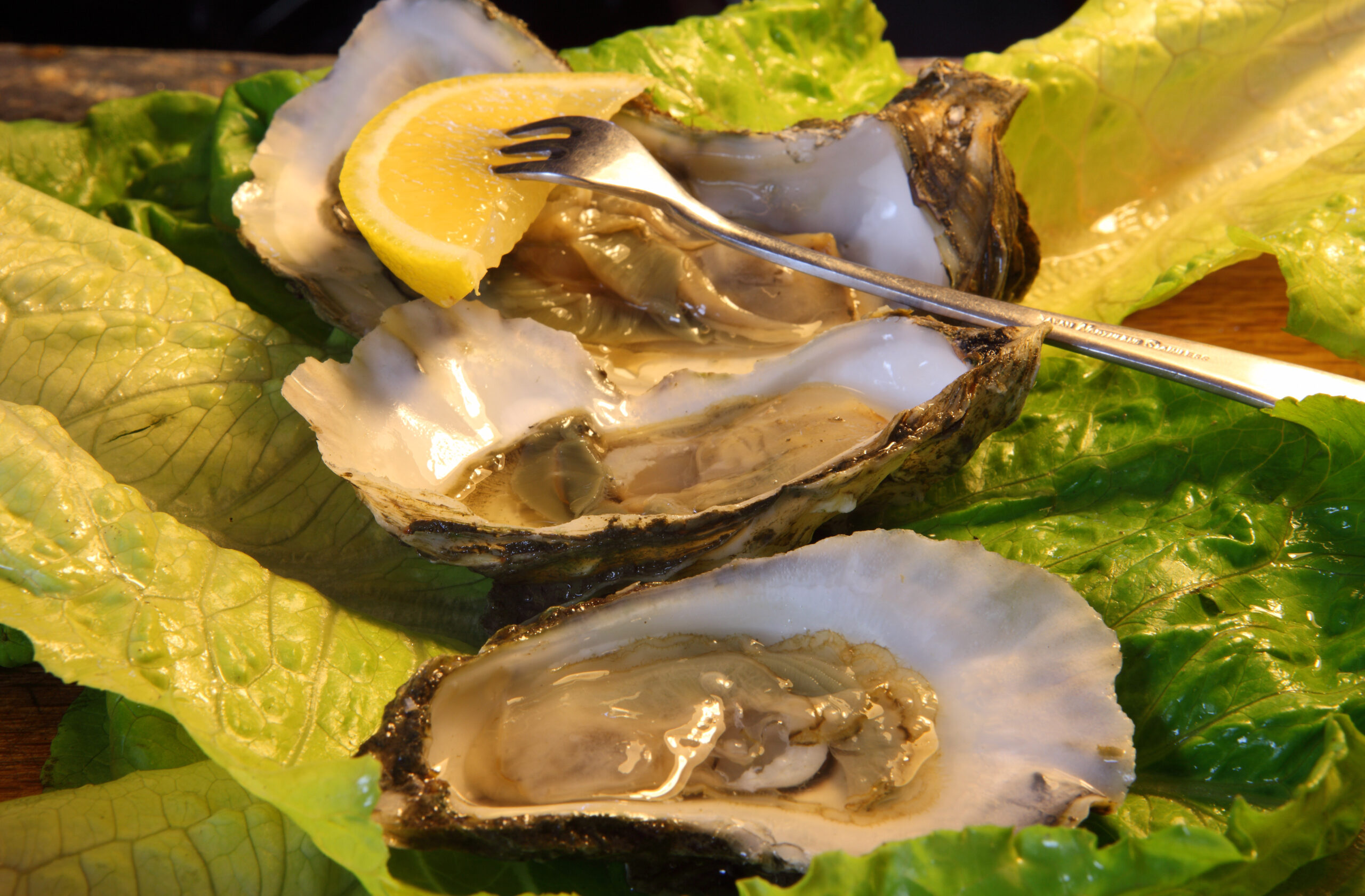Inside a modern room at the top of Rose Bay Oyster Company headquarters, Connell Purvis pitches his newest product — a “lightly breaded and crisp” oyster wrapped in bacon.
“We don’t use bits and pieces of oysters,” says Purvis while standing near a window that overlooks Rose Bay in Swan Quarter. “We use a whole oyster for this product. Also, there is less than 10 percent breading. This will be our first bacon-wrapped oyster.”
The new product is just one item that Purvis showcases to Canadian seafood buyers on a marketing trip sponsored by the N.C. Department of Agriculture and Consumer Services. Purvis also touts oyster stew made from his mama’s “old-fashioned recipe” and steamed oysters.
The bacon-wrapped oyster, which is a “value-added product,” debuted recently at the 2004 International Boston Seafood Show. Barry Nash, North Carolina Sea Grant seafood technology and marketing specialist, guided the development of the new seafood item.
Value-added products are processed to create new forms, flavors and textures from a variety of raw ingredients. Nash says that “value,” in this context, means “using processing techniques, novel ingredients or packaging to enhance the health attributes, the sensory characteristics, or the shelf life of food.”
Traditionally, the Rose Bay Oyster product list consisted of seafood products to be used as ingredients, including fresh-shucked oysters.
“We are aggressively moving into value-added products,” says Purvis, general manager of Rose Bay Oyster Company. “This company has been around for 75 years. We are at a real crossroads. If we don’t come out with something now, we will be gone.”
Of the three items showcased to Canadian buyers, the oyster seemed to be the most appealing. “Everybody likes bacon-wrapped items in the food industry,” says Mark Tytel of Export Packers in Ontario. “It has added value to whole oysters. The hardest part will be educating consumers about the product.”
New Seafood Projects
At North Carolina seafood companies, more value-added projects are on the horizon.
For more than 18 months, Nash has been working with Sea Safari Ltd. and Carolina Seafood Ventures LLC to develop a line of products, including a devil crab, crayfish cake and crab cake. The process includes concept development, formulating the product, sensory testing, analyses for nutritional labeling, and shelf-life evaluations.
The value-added products were developed with funding from the North Carolina Fishery Resource Grant Program (FRG).
With the competition from foreign markets, creating prepared seafood offers more profit opportunities to domestic processors than selling seafood commodities, according to Nash.
“When creating new products for the food service industry, American seafood processors can identify trends and satisfy the needs of American consumers faster than foreigners,” he adds.
In North Carolina, blue crabs are the most economically valuable fishery. However, landings have declined, while imports of crabmeat have increased.
This combination has led to half of the state’s crab processors shutting down in the last five years, according to the N.C. Division of Marine Fisheries.
To counteract the decline in the sale of North Carolina crabmeat, processors are turning to new products.
In 2000, Jimmy Johnson and his wife, Donna, sold their crab processing business in Washington because it had become too difficult to compete with imported products on a cost basis and virtually impossible to make a profit.
“It got to the point where you could not solely produce crabmeat and remain profitable,” says Johnson, who then joined Sea Safari Ltd in Belhaven. “We had to sell the business or lose everything we had worked our whole lives for.”
Johnson joined Raleigh marketing consultant Laura Ritter, Purvis and Nash in a product evaluation of several items, including a spicy crayfish cake, at the sensory laboratory at North Carolina State University’s Food Science Department.
“We can raise or lower the heat level to moderate the spiciness of this crayfish cake,” says Nash.
For the lobster morsel, the tasters agree that it needs heavier breading.
The processors have chosen products that have the greatest probability for success in the marketplace, according to Purvis. “We looked at whether the price is compatible with other products,” he adds. “We are specifically trying to identify niches for seafood.”
Large food companies have many chicken and vegetable entrees but not many seafood items, says Purvis.
To better market the products, Carolina Seafood Ventures has hired a North Carolina-based food broker. “We are finalizing product development and trade programs and figuring out where to distribute the products,” says Ritter.
Variety, Flavor, Shelf Life
FRG is a unique program that supports the development of value-added items. Funded by the North Carolina General Assembly and administered by North Carolina Sea Grant, the program helps people in the fishing and seafood industries to develop ideas for improving their businesses and the resources they depend upon.
Nash points to the success of Wanchese Fish Company, Inc. in developing the Scallop Medallion through a previous FRG project, using enzymatic cold-binding to create large scallops from smaller, less profitable ones.
The Sea Safari FRG began as a project to find out how textured vegetable proteins can add value to processed or cooked seafood, Nash says. He and Sarah Harris, Sea Safari’s former director of research and development, proposed creating four new products: shrimp and crab appetizers, an inexpensive crab cake to target an economy market, and a higher priced crab cake to appeal to more affluent customers who shop online.
Results exceeded expectations. The company’s list of value-added seafood grew from four to 26.
Nash also is helping Don and Doug Cross of Pamlico Packing Company in Vandemere to develop a line of seafood dips and salads that offers a 30-day refrigerated shelf life. The preservation system, which controls bacteria and growth, was developed through an FRG project.
Doug Cross says that he turned to value-added products when the raw seafood business began to fall off.
“I think value-added is the wave of the future,” says Cross. “Consumers are looking for an easy way out at lunch or dinnertime.”
Pamlico Packing’s new line of 12 value-added products, including shrimp pasta salad, cajun crayfish pimento cheese and hot crabmeat dip, will debut this spring.
Nash also will use the new preservation system to help Jerry Smith, “Chef Dirt” of Dirt Enterprises, Inc. in Harbinger, to extend the shelf life of devil crab, smoked salmon, shrimp, crab and tuna dips now sold in grocery stores along the Outer Banks. All the dips are made from fresh ingredients.
“The products now have a 14-day shelf life,” says Smith. “I am getting ready to expand (the distribution of) the line to Washington, D.C., Virginia and Baltimore and need to lengthen the shelf life beyond two weeks.”
Nash’s work includes items that compliment seafood. Recently, he helped Carteret County food entrepreneur Priscilla Livingston reformulate a line of vinegarettes that can be used on seafood and meats for the growing specialty foods market.
“Priscilla’s sauces were formulated with costly ingredients such as olive oil,” says Nash. “I worked with her on using lower-cost ingredients like canola oil that don’t sacrifice product quality. Also, I used an emulsifier to prevent oil and vinegar separation, thereby enhancing the visual quality of her products. In addition, I helped her convert her recipes so that they could be batched, cooked and packed on a mass-production basis.”
Canadian seafood buyers who have traditionally bought N.C. seafood commodities say they foresee a bright future for a wide variety of value-added products.
“Value-added products are useful, especially for small restaurants and banquets,” says Gus Nikoletsos of City Fish Market in Toronto. “In Canada, the banquet market is huge.”
This article was published in the Spring 2004 issue of Coastwatch.
For contact information and reprint requests, visit ncseagrant.ncsu.edu/coastwatch/contact/.
- Categories:



